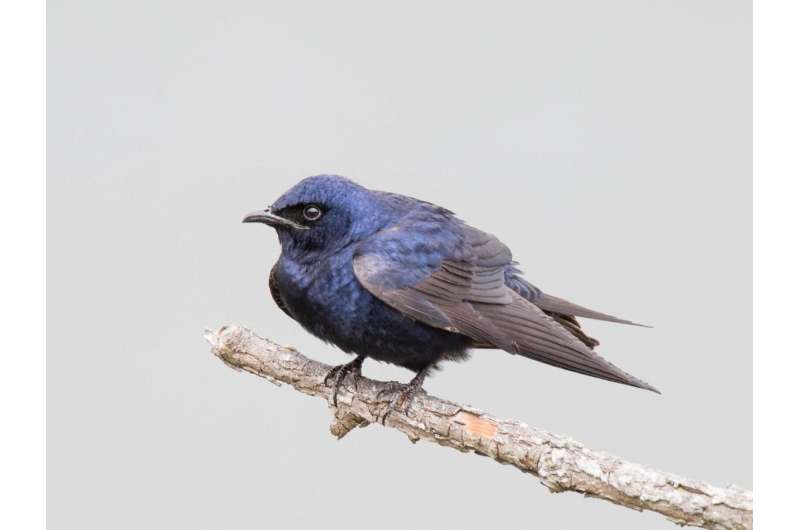A (sorta) good news story about a songbird and climate change

University of Manitoba researchers made a recent discovery that suggests Purple Martins, unlike other long-distance migratory songbirds, show promise of being able to adapt to climate change.
The Purple Martin's (Progne subis) breeding range spans from Florida to northern Alberta, and the smartphone-sized songbird passes our winter months on small islands in the Amazon river, 10,000 kilometers south of Canada's prairies. So far away, they lack all cues on what is happening in northern environments, and that is problematic because as the climate warms, spring arrives earlier and earlier in northern latitudes, meaning the insects these birds depend upon on are hatching earlier—often before these birds arrive, famished and stressed.
If the birds are going to survive in Canada, they need to arrive earlier and then breed without delay. Is natural selection pressure bringing this about?
In their December 2019 Ecosphere paper, "Timing to temperature: egg laying dates respond to temperature and are under stronger selection at northern latitudes," biological sciences masters student and lead author Amanda Shave, her Faculty of Science advising professor Kevin Fraser, UM collaborator Colin Garroway, and Joe Siegrist, leader of the Purple Martin Conservation Association examined 20-years-worth of previously unutilized data collected from citizen scientists, looking at the records of 28,165 nest sites.
"Surprisingly, we found that martins could adjust the timing of their nesting— later in cool springs and earlier in warm springs—which is good news in that they have some flexibility to changing conditions. In the few other long-distance migrants that have been studied they have seemed less flexible in their timing," Shave says.
And indeed, the birds that laid their eggs earlier, fledged more young than those that nested later.
"However, our results may also be an early warning that martins breeding at more northern latitudes are not adjusting fast enough. We show that there was pressure across the range to nest earlier (with earlier springs) and this was the strongest at more northern latitudes, like in Canada," Shave says.
For the birds to do well at northern latitudes, they have to migrate earlier, Shave and Fraser say. It remains unknown if they can do that, but Fraser's lab is testing some bold ideas on this front, which we will report on at a later date.
More information: Amanda Shave et al. Timing to temperature: Egg‐laying dates respond to temperature and are under stronger selection at northern latitudes, Ecosphere (2019). DOI: 10.1002/ecs2.2974
Journal information: Ecosphere
Provided by University of Manitoba




















